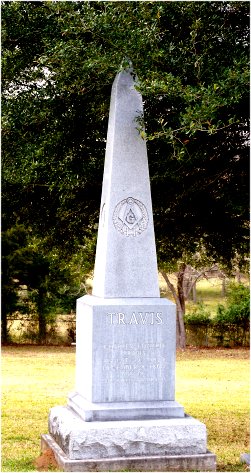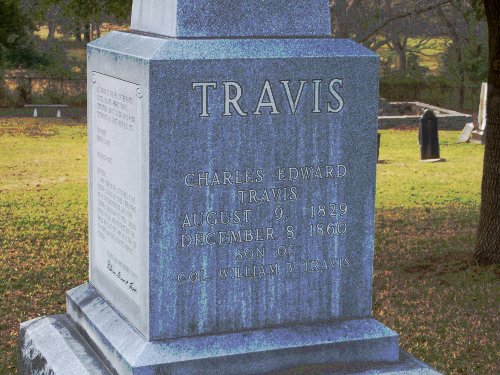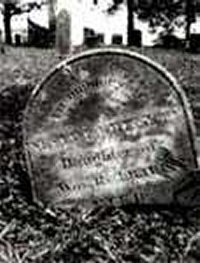

Mt. Hiram Masonic Lodge #595 AF & AM 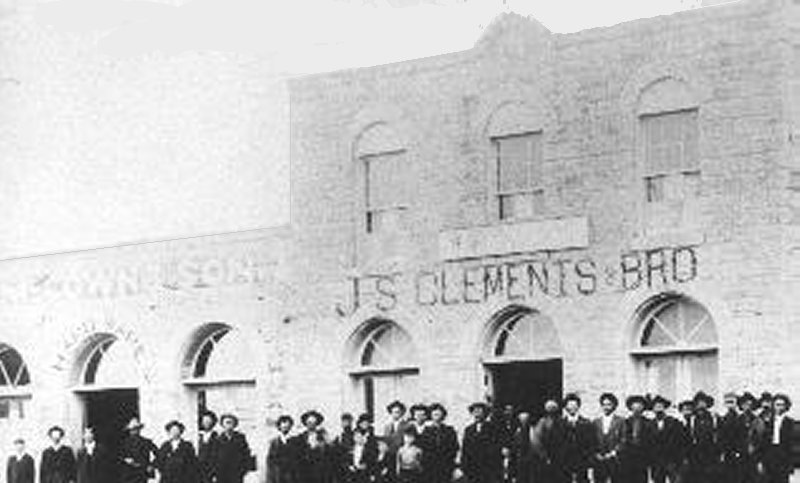 The Mt. Hiram Lodge's Second Lodge Above Clement's |
|
Page II | |||||||||
This Small Town Texas Mason's E-Magazine is not affiliated with any state Grand Lodge or individual Blue Lodge. It was created to enlighten, educate and entertain Masons and non-Masons alike and as title suggests, it does feature a small town Texas Masonic Lodge and a story of Texas Masonic history in each issue
A very sincere effort was made to avoid using any copyrighted material, without permission or giving credit to the author, in the creation of this web site. If you discover something that is yours, without giving you due credit, please let me know and due credit will be given or the item will be replaced.
Any material in this site may be used to increase the understanding of Freemasonry.
Story tools: |
Mt. Hiram Masonic Lodge #595 AF & AM.
James Bowie - "Greatest Fighter in the Southwest"
An Insider Tour of the Masonic Lodge
A Texas Masonic Lodge Membership On The Increase
The Sisters Who Become Brothers
Brother Israel Israel: "Saved By Masonic Sign O Distress"
"Brothers War": A Masonic Movie
Chappell Hill Masonic Cemetery
| ||||||||
|
Page V | |
James Bowie "Greatest Fighter in the Southwest"
From The Texas Mason
Henry Clay declared Bowie "the greatest fighter in the Southwest." Clay had witnessed a confrontation between Bowie and an obnoxious pipe smoker on a stagecoach in 1832. When a lady's request that the pipe be extinguished was ignored, the gallant and daring Bowie produced his famous knife and caused the fellow to reconsider.
Although the records were destroyed by fire in 1850, he is recognized as a member of Loge L'Humble Chaumiere (Humble Cottage Lodge) No. 19 at Opelousas, Louisiana.
Bowie came to Texas in 1830 and settled in San Antonio, where he married the beautiful Ursula Veramendi, daughter of the Vice-Governor of Coahuila and Texas. With these connections to the established aristocracy, Bowie became one of the most trusted Americans in Texas. But just when the future seemed brightest, his wife and two children died in the great cholera epidemic of 1833.
Bowie joined the struggle for Texas Independence at the siege of Bexar, and accepted the command of the volunteers at the Alamo. On February 2, 1836, he wrote, "we will rather die in these ditches than give them up ...." True to his word, he chose to remain with the defenders of the Alamo, although confined to his cot with pneumonia.
The British historian Thomas Carlyle said of Bowie, "By Hercules! The man was greater than Caesar ... The Texans ought to build him an altar." | |
|
Author Unknown
A member of a certain Lodge, who previously attended meetings regularly, stopped going. After a few months, the Worshipful Master decided to visit him. It was a chilly evening, and the Worshipful Master found his brother at home alone, sitting before a blazing fire.
Guessing the reason for the Worshipful Master's visit, the brother welcomed him, led him to a comfortable chair near the fireplace and waited. The Worshipful Master made him self comfortable, but said nothing.
His host watched all of this in quiet contemplation. As the one, lone ember's flame flickered and diminished, there was a momentary glow, and its fire was no more. Soon, it was cold and dead. Not a word had been spoken since the initial greeting. The Worshipful Master glanced at his watch and chose this time to leave. He slowly stood up, picked up the cold, dead ember, and placed it back in the middle of the fire. Immediately, it began to glow once more, with all the light and warmth of the burning coals around it.
As the Worshipful Master reached the door to leave, his host said, with a tear running down his cheek, "Thank you so much for your fiery summons, my brother. I'll be back in our Lodge next meeting." |
|
Page VII |
The Masonic Lodge interior seems to be so well organized, and
thought out, yet it holds many mysteries to the young Mason.
It takes a bit of time to understand the function of each officer and the layout of the lodge interior. After reading this page, you should feel more comfortable amongst your brethren when you come to the Lodge meeting next month. The area of the Masonic Lodge that is commonly referred to as the "East" is where the Master of the lodge is seated. The Master of the lodge is elected by the brethren of the lodge annually. He is the "boss", and the ruling of the lodge rests squarely on his shoulders. The Master is like the CEO of the group.
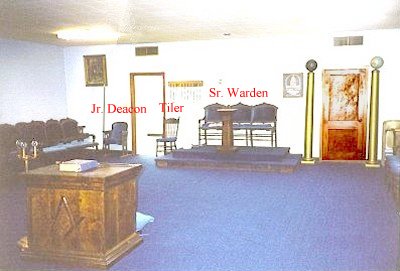 Directly across the lodge from the Master in the West is the Senior Warden seat. The Senior Warden is the #2 man in the line up. The Junior Warden is seated in the South of the lodge to the left of the Master in the East.
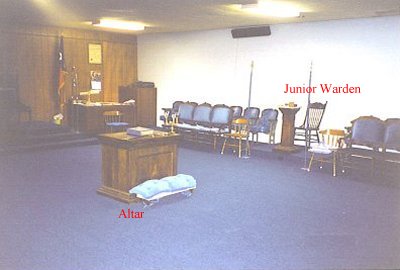 The Junior Warden, Senior Warden, and the Master, are the top 3 officers of the Masonic Lodge. All officers will assist in the day to day functions and of course, at the meetings. The Secretary's Desk is to the left of the Master's station. His duty is to record all Lodge proceedings. He is also in charge of receiving all incoming money. He will turn the money over to the Treasurer. To the right of the Master is the Treasurer seat. His duty is to pay bills approved for payment and conduct financial affairs for the lodge. Both Treasurer and Secretary will perform a variety of duties that are critical to the success and smooth functioning of the lodge. The Senior Deacon is seated to the right of the Worshipful Master the right and in front of the Treasurer. His responsibility includes the introduction of lodge visitors. The Junior Deacon is seated in front and right of the Senior Warden. The Junior Deacon's place is just inside the door of the Lodge Room where he serves as The Inner Guard. He also is responsible for the admitting of members and visitors. The Outer Guard is called the Tiler in many lodges. He will remain outside during meetings to make sure only qualified people enter. The Masters of Ceremonies are usually appointed by the Master. Their place is in front on either side of the Junior Warden. The Chaplain looks after the spiritual side of the Masonic Lodge. The altar is placed in the center of the Masonic Lodge and you will find one in every lodge. The book that is on the altar will vary depending on the lodge location and the beliefs of the brethren in the area. Don't be surprised to see more than one book on the altar.
(Pictures - Waller Lodge #808 AF & AM) |
|
Page VIII | ||
By Corky
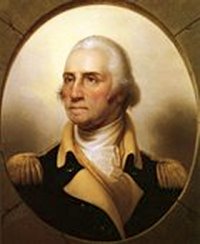 I was reading the article, “The Eye in the Pyramid ”, by Brother S. Brent Morris, P.M. that started out by stating, I was reading the article, “The Eye in the Pyramid ”, by Brother S. Brent Morris, P.M. that started out by stating,
“Historians must be cautious about many well-known “facts.” George Washington chopped down a cherry tree when a boy and confessed the deed to his father. Abner Doubleday invented the game of baseball. Freemasons inserted some of their emblems (chief among them the eye in the pyramid) into the reverse of the Great Seal of the United States. These historical “facts” are widely popular, commonly accepted, and equally false.” Then I read in James Barron's article entitled “A Secret Society, Spilling a Few Secrets,” he states in what to me, seems an accusatory manner,
“For more than two centuries, the Freemasons and their grandiose rituals have played a secretive, mysterious role in American life. One of the Masons' symbols looks a lot like the all-seeing eye on the back of every $1 bill. And look whose picture is on the other side.”
Yes, the intersections of Massachusetts Ave., Road Island Ave., Connecticut Ave., Vermont Ave. and K Street NW form a five pointed star. It is also true that many of the city's architects in the nineteenth and early twentieth century were freemasons. From these two facts, and a vivid imagination, many writers have concluded that the city was intentionally planned to promote an occult agenda. In the first place, the pentagram or five pointed star has never been associated with the Masonic Lodge. And yes, the female organization for relatives of Masons, the Order Of The Eastern Star, uses the five pointed star as their symbol. However, the Eastern Star was founded by Dr. Robert Morris in 1849/50 and the street plan for Washington, D.C. had been designed 60 years earlier in 1791. So, it should be obvious, even to anti-Masons, that the street plan of Washington, D.C. has no connection to the Freemasons. George Washington, a Freemason, did commission Pierre Charles L'Enfant and approved the street plan drawn up by Andrew Ellicott and Benjamin Bannaker who were not freemasons. And, contrarily to anti-Mason claims, there is no indication that Charles L'Enfant was a Freemason and in his obituary, published in the June 25, 1825 edition of the National Intelligencer there was no mention that he was a freemason. Actually. although L'Enfant was hired by George Washington most of his relationship with the goverment went through Thomas Jefferson who drew the original street plan that L'Enfant and company worked from to draw the street plan. OK, so George Washington was a Freemason and his picture is on the dollar bill. He was probably the foremost leader in gaining independence from England and forming the United States of America that we have now. He was the General who led the Continental Army to defeat the British and win independence for the new country. He turned down the offer to crown him as the King for life and instead served an elected term as the first President.
|
|
Page IX | ||||
Continued From Page VIII
Does that theory sound ridiculous? Of course it does and so does the idea that Washington's picture being on the dollar bill means that the United States is being run by the Freemasons. George Washington's life and his writings are ample proof that he was a Christian, so why wouldn't the United States have been formed by Christians rather then Freemasons. Regarding the eye in the triangle above the pyramid, the words are the Latin words "Annuit Coeptis." This translates to "He has favored our undertakings." This line is associated with the "Eye of Providence" which has absolutely nothing to do with Freemasonry.
Could it be that the eye in a triangle on the dollar bill is the Christian symbol rather than a Masonic one? After all, almost all members of the new government were Christians and only a few were Masons. What a blow to the Christian Masonic conspiracy advocates.
The Vietnamese religion Cao Dai, as well as a number of other churches, uses the Eye of Providence (specifically, the left eye) within a triangle is used to represent God. According to some UFO witnesses, On Independence Day in 1776 three men, Benjamin Franklin, Thomas Jefferson, and John Adams, along with Pierre Eugene du Simitière as a consultant and artist were formed as a committee to create a great seal for the new government of the United States of America. Only Benjamin Franklin of these four men was a Mason, and he contributed nothing of a Masonic nature to the committee's proposed design for a seal. Du Simitière, the committee's consultant and a non-Mason, contributed the ideas of using the shield, the slogan, E Pluribus Unum, the date, MDCCLXXVI, and the eye of providence in a triangle (a Christian symbol).
So much for Freemasonry and secret Masonic symbols having an influence on the present form of the United States government.
I would have to close with the thought that if the Masonic plan is to rule the government, their plan must be one of the biggest failures in history. After all they have had way over 200 years to do it.
|
|
Page X | |
Dan Eakin, Staff Writer
There have been some lean years during the past few decades, but Larry FitzPatrick, master of the Lodge, said there has been a renewed interest in the last couple of years.
"Our Lodge has been an integral part of the Lewisville area for over 150 years," FitzPatrick said, "although, for a period of time probably not as active as it could have been. The declining number and aging of the membership were the main reasons for our inactivity. Most fraternal organizations have suffered the same setbacks in recent years, primarily because there are so many other things to occupy a persons time. "Today's world is not the same as it was 75 and 100 years ago when fraternal organizations were at their peak," FitzPatrick said. "Curiously, we have seen a resurgence of interest, and an increase in membership in the last couple of years."
FitzPatrick said recent movies and television programs about Masonic Lodge activities are not the reason for the recent increases in lodge members. "In a recent survey of our membership, we discovered that it was not due to the publicity of movies such as National Treasure or documentaries on the Discovery Channel as we suspected, but more due to the fact that men were looking for a place to find help dealing with the issues of day-to-day life," he said. "They were drawn to the Lodge because they had a friend or relative, often times their grandfather, who had been a Mason, and had a special admiration they felt stemmed from his being a Mason.
FitzPatrick said the mission of the Lodge is "to help good men become better men. Our unique ability to bring men from all walks of life -- different generations, religions, races and income levels -- together on a level field, is again gaining popularity."
Five longtime members of the Lewisville Lodge will be honored in a special ceremony Thursday night at the Lodge location at 603 Minco Road.
They include Charles Mesnard, who has been a member for 65 years; Evan Thomas, Edwin McEver and Fred Kunz, who have been members for 60 years; and James Heath, who has been a member for 50 years.
The Lodge's next major event, the 2008 Race for the Children, will take place Sept. 13. Registration will take place from 6:30-8 a.m. at the greenbelt next to Lewisville City Hall, located at 151 W. Church Street.
People of all ages will be invited to participate in a 1-mile fun run or in a 5K race. An awards ceremony will follow.
Proceeds will go to the support of the Texas Scottish Rite Children's Hospital in Galveston and the Lewisville Independent School District. Last year, the Lewisville Masonic Lodge gave $2,750 to the Scottish Rite Children's Hospital and $3,750 to the LISD for scholarships and to support the Learning After the Bell program. "In March 2007, our Lodge celebrated its 150th anniversary," states a brochure advertising the upcoming races. "This marked the beginning of a renewed emphasis on our charitable responsibilities and community involvement."
"We have approximately two hundred fifty members on our rolls, fifty of whom are active in some way and about 30 -40 who are involved on a regular basis. Of the surveys we sent out, about fifty five actually responded. We also make it a practice to interview our incoming candidates about their reasons for joining the Lodge. We were fortunate last year to raise twelve Master Masons and are on a pace to do at least that many again this year. In the ten years prior to 2005, we were lucky to raise two or three. Most of our new members are in their twenties and thirties and indicated that they joined for the reasons cited in the article. We also recently introduced a system of job descriptions and committee assignments that has really started to help get things done and get everyone involved.
Larry | |
|
I was born in antiquity, in the ancient days when men first dreamed of God. I have been tried through the ages, and found true. The crossroads of the world bear the imprint of my feet, and the cathedrals of all nations mark the skill of my hands. I strive for beauty and for symmetry. In my heart is wisdom and strength and courage for those who ask. Upon my altars is the Book of Holy Writ, and my prayers are to the One Omnipotent God, my sons work and pray together, without rank or discord, in the public mart and in the inner chamber. By signs and symbols I teach the lessons of life and of death and the relationship of man with God and of man with man.
My arms are widespread to receive those of lawful age and good report who seek me of their own free will. I accept them and teach them to use my tools in the building of men, and thereafter, find direction in their own quest for perfection so much desired and so difficult to attain. I lift up the fallen and shelter the sick. I hark to the orphans' cry, the widows tears, the pain of the old and destitute. I am not church, nor party, nor school, yet my sons bear a full share of responsibility to God, to country, to neighbor and themselves. They are freemen, tenacious of their liberties and alert to lurking danger. At the end I commit them as each one undertakes the journey beyond the vale into the glory of everlasting life. I ponder the sands within the glass and think how small is a single life in the eternal universe. Always have I taught immortality, and even as I raise men from darkness into light, I am a way of life.
- Ray V. Denslow. 1933
|
|
Page XI | ||||
Why would any sensible woman join the Masons, a secret society ruled by men who dress up in strange clothes and practice arcane rituals? Mira Katbamna went to find out
Freemasonry has never enjoyed a particularly good reputation. Hounded by accusations of cronyism, inscrutability and sexism, Masons were also persecuted by the Nazis (Hitler believed they were trying to bring down Christianity), and today they endure "revelations" posted all over the internet by numerous conspiracy theorists, not to mention fans of Dan Brown's The Da Vinci Code.
Val Gibbens, Grand Secretary of the Honorable Fraternity of Ancient Freemasons based in north London, likes to think of the Freemasons not as a secret society, but "a society with secrets". What is not secret is its maleness.
Women, however, have always been involved in Freemasonry. The first known woman Mason, Elizabeth St Leger, was admitted in 1735, after she was caught spying on her father's lodge (she is said to have been given the choice of death or immediate initiation - unsurprisingly, she decided to sign up). Women now practice "the Craft", as it is known, separately from men, but they have been at it formally since 1913. Although nobody knew that until the mid-90s - when the United Grand Lodge of England (UGLE), the body that controls men's Freemasonry, decided to become more open - because it was, of course, secret.
The Honorable Fraternity of Ancient Freemasons is one of two women's fraternities in the UK, and between them they have around 350 lodges, each with between 25 and 100 women attached. Even taking into account the fact that a Freemason can belong to more than one lodge, there must be at least 10,000 women Masons in the UK. That is 10,000 women who all call each other Brother, and, until recently, referred to each other as "he" and "him".
It sounds absurd, but Gibbens says it is all part of remaining true to the spirit of Masonry. "Women's Freemasonry grew out of the Co-Masonry movement that developed in the 1800s, so women Masons had guidance from men from the beginning," she explains. "We take the men's book of laws, their book of constitutions, and if we have a point of procedure we are unhappy about, then we have conversations with their Grand Secretary to make sure we continue to be seen as regular."
In fact, in 1998, the UGLE issued a statement saying that it acknowledged the existence of women practicing Freemasonry in a way deemed to be "regular" (conforming to the rules of UGLE) but that it did not "recognize" women's Masonry: in other words, men could not visit women's lodges and vice versa. Janet Wayman, a lawyer in the City, and Master of a south London lodge, does not think it matters. "For some of the men, and particularly the old school, we don't exist and probably never will do. But that doesn't affect my enjoyment of Masonry."
Wayman does not seem the type to join a secret society, any more than Gibbens. A keen motorcyclist, Wayman is a thoroughly modern woman, but says Freemasonry has made a huge difference to her life. "People think Freemasonry is all about stuffy old ladies getting together on a Tuesday afternoon," she says, "but I have benefited big time from Masonry. I am much more confident, it's done wonders for my self-esteem and I am much more understanding and giving. It's made me a happier, more fulfilled person."
But what is it that Freemasons do that has such an extraordinary effect? Back in Golders Green, Gibbens takes me into the main meeting room: the Temple. Passing through two wooden pillars mounted with globes, the room is filled with exactly the kind of strange and esoteric looking objects you would expect of an arcane organization. A dais with a Bible takes pride of place, and seven intimidating, high-backed wooden chairs adorned with suns and set squares line the wall behind it. The floor is laid with a huge checked carpet, and on the walls hang the pennants of the different Lodges that meet in this room. Slightly less antique in appearance, there is also what appears to be a battered electronic keyboard still in its box propped up against a wall. It is easy to imagine that someone being brought in here to experience a ritual could undergo a transforming experience. |
|
Page XII | |
Continued From Page X
Gibbens says meetings in the Temple are split into two halves. "It's all about symbolism, really," she says. "First of all we deal with the business of the day, and then we have people moving through the various stages of Freemasonry. So you start at the beginning and you finish at the other end." Clearly, it is the second half that distinguishes Freemasonry from flower arranging with the WI. Freemasonry is "a peculiar system of morality, veiled in allegory and illustrated by symbols", which in layman's terms means, I think, that Freemasons perform prescribed dramatic rituals to understand the world, the meanings of which are revealed as the individual proceeds through the stages, or degrees, of Masonry. "It's really about coming, being and going, and it's a way to express a certain companionship," says Gibbens.
After the meeting, the Honorable Fraternity gather in their dining room to share a meal, known as the Festive Board. The plastic fold-away tables clash with the enormous gilt-framed paintings of the first Grand Masters of the fraternity in their full regalia. Clearly early Freemasons really were women with money and power, but who are they today? Gibbens joined in 1979, and says members range from those in their 20s to those in their 90s. "We have barristers, lawyers, actresses, and shop workers, a complete range across the board," she says. "But once we're in, we're Masons." Wayman agrees. "Everyone starts at the bottom and it's a completely level playing field. At the end of the day you realize that it's not about what you achieve in the outside world that earns you respect, but how you treat others." That is all very well, but is it just jobs for the girls? Wayman points out that one condition of becoming a Freemason is that you do not use Masonry for pecuniary advantage, but she admits that Masons network in much the same way as any other society. "Masonry attracts a very broad range of people, so obviously your circle of contacts is much wider than it would be otherwise," she says. "If I needed a builder and a fellow Mason's husband was a builder, I'd probably use them simply because they were someone I knew." Nowadays, you do not have to be invited to join. In fact, the criteria are straightforward: you must be over 21 and you must have a belief in a Supreme Being, but you do not have to be of a particular religion - in fact, discrimination on the grounds of religion or race would be considered, according to Gibbens, very un-Masonic. So can I join? "It's about how you fit in. Once you've had a two-way conversation, you can decide whether the organization is for you, and if it is what you think it is, then you'd be accepted," she explains. During that conversation you'll be read a two-page extract from the Freemason's rule book, informing you that Freemasonry exists to preserve the secrets of the Fraternity. The candidate should be able to confirm that "he sincerely desires the intellectual and moral improvement of himself and his fellow creatures, and that he is willing to devote part of his time, means and efforts to the promotion of brotherly love, relief and truth".
It all sounds very worthy, but not very 21st century. Gibbens remains unconcerned that it may become difficult to attract new Brothers. "We might become a leaner organization," she concedes, "but then I suspect that the people who will want to come in are the people who are going to be the people who ought to be in." Well that clears that up then.
| |
|
Collected by Ray Dotson
The oldest known Masonic writing, the Regius Manuscript or "Poem of Moral Duties," was discovered to be a Masonic document by a non-Mason, J. O. Halliwell, in 1839. It was written about 1390 and was given the name "Regius" because it was found in the Royal Library of England. It is now a part of the British Museum. Some common Masonic Ritual terms in use today are found in it such as "So Mote It Be."
In 1920, Gate City Lodge #522 in Kansas City MO met every day of the week except Sunday to confer a record 1,107 degrees, averaging 21 degrees a week.
Music written by Brother John Stafford Smith (1750-1836) of Inverness Lodge #4 in London was, at one time, used by an Irish Masonic Orphans' Home as their song. Later it became a popular drinking song for many years known as To Anacreon in Heaven. Then, some years later, the music was adopted by Francis Scott Key to which he wrote the words to our National Anthem, The Star Spangled Banner.
In 1860 in Limerick, Ireland, there was found in a small chapel a stone dated 1517 with the following inscription:
"I will serve to live with love & care
Upon the level, by the square."
The Commissioner of Patents In 1872 ruled that the Masonic Square and Compasses emblem could not be used in any trademark or trade name for commercial purposes.
|
|
Page XIII | |
Saved By Masonic Sign O Distress By Andrew A. Zellers-Frederick, Executive Director, The Masonic Library and Museum of Pennsylvania
The American Revolution remarkably produced many great men who are revered for their patriotism, bravery and devotion to the glorious cause that founded our nation. The supporters of the Declaration of Independence included prominent Pennsylvania Masons such as Brothers Benjamin Franklin, Charles Willson Peale, Anthony Wayne and Haym Salomon, who each contributed their individual expertise to the war effort. One extraordinary Mason whose daring exploit is usually forgotten (and whose double name under his Grand Master's portrait in the Masonic Temple is often a mere curiosity to visitors on a tour) is Bro. Israel Israel.
The onset of hostilities with Great Britain prompted Bro. Israel to join the local patriotic Committee of Safety and to support the American war effort wherever possible. This also caused him to sacrifice his fortune. These activities made him a marked man, as many of Bro. Israel's neighbors maintained their allegiance to the British Crown as Loyalists. The opportunity to capture Israel came when a British frigate, the Roebuck, anchored on the Delaware River opposite Israel's farm. The Roebuck's commanding officer, Captain Andrew Hammond, was informed that Bro. Israel reportedly declared he would sooner drive his cattle as a present to General Washington, than to receive thousands of dollars in British gold for them. The statement has probably been paraphrased as the story was told and re-told, but the essence of his patriotic spirit is undoubtedly clear. While Bro. Israel was traveling back from a visit with his mother in Philadelphia, he and his brother-in-law were seized and taken as prisoners onboard the warship to stand trial for treason. As a prisoner on the Roebuck, Bro. Israel was harshly treated - purportedly given the worst of the ship's food and made to sleep on deck in a coil of ropes. It was decided that Bro. Israel would stand trial with the ship's officers to serve as his judge and jury. In the meantime, Captain Hammond ordered a detachment of the ship's Marines to land and seize the animals from Israel's farm. Hannah Israel witnessed the embarkation of the British party into small boats and quickly guessed the mission of the Marines. Despite the hostile musket fire directed at her, Hannah kept her wits and heroically drove the cattle away beyond the reach of the British shore party. From the deck of the Roebuck, Bro. Israel and Hannah's brother undoubtedly witnessed the entire affair with horror, fearing for the brave young woman's safety, but proud of her courageous actions. Before the trial commenced, a kind-heated sailor privately asked Bro. Israel if he was a Freemason. Following an affirmative reply, the sailor informed Bro. Israel that a lodge was held on the warship and the officers, who were Masons, were conducting a meeting that night. The trial probably did not begin well for Bro. Israel, as his Loyalist accusers were confident he would be convicted and executed for treason against the British Crown. Given the opportunity to explain his actions and mount a defense, Bro. Israel displayed the Masonic sign of distress to the ship's officers gathered to pronounce his fate. Upon recognition of the sign, the tone of the proceedings changed dramatically and instantly, as the British officers' hardhearted demeanor transformed into those of sympathy and admiration. Bro. Israel's Loyalist accusers were rebuked for their testimony against such an honorable man and the court was subsequently dismissed. The British officers ordered transport for Bro. Israel and his brother-in-law back to land and gathered a small gift for Hannah. The records of the Grand Lodge of Pennsylvania bear witness to Bro. Israel's salvation from almost certain death through Freemasonry.
|
|
Page XIV | |
Saved By Masonic Sign O Distress Continued From Page XII
Bro. Israel undoubtedly gave up his farm after that incident and returned to Philadelphia, where he tried a number of vocations to re-establish himself. At some point he was an innkeeper of two different taverns-the Sign of the Blue Lion, located in Society Hill, and The Sign of the Crossed Keys (a Masonic image comes to mind of the Lodge Treasurer's jewel) located at Third and Chestnut Street. He was a shopkeeper in Cater's Alley, below Third Street from 1785-1804.
In a time when political positions were held in addition to one's usual vocation, he became politically active in support of the French Revolution in 1793 as a co-founder of the Philadelphia Democratic Society. The Federalist Party was not supportive of the Revolution, and used anti-Semitic slurs against Bro. Israel and his son, John, to try to hold onto their party members and votes. Ironically, by this time, neither were practicing Jews, having assimilated into society by marrying Christians and joining Christian congregations, but the name made them an easy target. He served one term in the Pennsylvania State Senate from 1797-1798. In 1800, he became the High Sheriff of Philadelphia and in 1816, he became Justice of the Peace for Philadelphia's 5th District. It is not known when Bro. Israel was made a Mason, although it is recorded he was admitted in May 1794 to Lodge No. 3 in Philadelphia, where he later served as Master for five six-month terms. From 1799 until 1801 he served as Deputy Grand Master and from 1803 through 1805 as Grand Master of the Grand Lodge. He became a member of Royal Arch Chapter No. 3 in 1796, and he served as Grand High Priest while also serving as Grand Master. As a loyal Mason, Bro. Israel regularly attended meetings and participated in a number of Grand Lodge committees, including one established in 1800 to arrange for meetings conducted in the Pennsylvania State House (later known as Independence Hall).
Bro. Israel died on March 17, 1822, at the then-advanced age of 78 and his remains are interred in South Laurel Hill Cemetery within Philadelphia's Fairmount Park. | |
|

From The "Brothers War" Website At, http://brotherswar.info/about_the_film.htm
Based on real events, the setting for Brother's War is the Eastern Front during the final days of World War II. In the midst of fierce fighting, as the Western Allies and the Russian Red Army make their advance toward Berlin, a British Army Officer attached to the Red Army discovers a secret that can shatter the unity of the Allies.
"The FREEMASONS during the war" (Historical Background)
Freemasonry is the largest fraternal organization in the world and the oldest, with a recorded history dating back at least as far as the 1400's. When the Nazis took power in Germany in 1933 they outlawed all unions, social societies, Freemasonry and other such organizations. The German Freemasons went underground and abandoned their lodges. They started wearing a "Forget Me Not” flower or a blue flower lapel pin, rather than the traditional Compass and Square, for the purpose of enabling them to recognize each other. Many German Freemasons joined the German Army and blended in, waiting for better times where they again could meet at
their Lodges.
As German soldiers invaded the countries around them, the SS raided the various Lodges and sent all the Masonic regalia to the SS Museum in Berlin. An interesting note is that before Adolph Eichmann was put in charge of Jewish affairs in the SS, he served as secretary for the SS museum. Freemasons were rounded up along with the Jews and confined to work and labor camps, only to later perish in concentration camps.
Throughout history, authoritarian regimes have gone out of their way to persecute secret societies, even to the present day, despite the fact that it is well known that Masonic Lodges do not involve themselves in matters of religion or politics. One of the reasons the Nazis gave for this persecution was that the Masons were helping the Jews of Germany in their alleged “world conspiracy." This was supposedly proven by the book “The Protocols of the Elders of Zion”, claimed to have been written by a 32 degree Mason, which describes this supposed world conspiracy. The book was later proven to be a fraud created by the Soviet Intelligence Agency to discredit the Jews around the turn of the century.
It is believed that many of the top leaders in Germany during the war had been Freemasons, Heinrich Himmler took a great interest in the organization and it was said that Göring was a Mason as well. When the war ended and the Red Army occupied Berlin, the Soviets took possession of all the Masonic regalia in the museum and send it to Moscow where it was stored until the 1990's, at which time the regalia was returned to the European Lodges from which it had been siezed by the SS during the War.
The Freemasons faired little better during Soviet Communist rule in Eastern Europe, where they were also persecuted and banned as an organization.
|
|
Page XV | |||||
Masons do lack a recognition symbol outside the lodge (unless you include the Grand Hailing Sign). This could be useful in this modern age when you stop at traffic lights alongside a car with a masonic rear sticker. So how do you salute your brother? The sign of an EA? That's not a very friendly gesture.
Some gestures, such as the ubiquitous act of pointing, differ little from one place to another, but most
gestures do not have invariable or universal meanings, having specific connotations only in certain cultures – and woe betide you if your beneficent hand movements are actually insulting to the person you're signing to!
The first full-length study of gesture was published by John Bulwer in 1644. Bulwer analyzed dozens of gestures, and provided a guide on how to use gestures to increase eloquence and clarity for public speaking.
John Bulwer 1606-1656 was an English physician and early Baconian natural philosopher who wrote five works exploring the body and human communication. He was the first the first person in England to propose educating deaf people.
Approximately
Mezzo-mezzo
This gesture is understood among various cultures or language groups; in particular the Spanish, French, and other Romance language groups use it.
Bunny ears/cuckold
The sign existed before the convenience of photography. It was typical tavern humor to signify a cuckold (a husband under
the control of his wife, or a husband whose wife is having an extramarital affair). The joke lay in the fact that the victim was usually unaware of the source of the humor.
Note the cuckold sign in this engraving by Bro William Hogarth. Although the sign is formed by the two horns of a
cow, the sign would have been instantly understood by all in the 18th century. Indeed the woman in the picture is large and
overbearing, the man, small and meek.
|
|
Page XVI | |||
Chappell Hill, Texas
The town became a commercial center for the local cotton plantations and in 1847 they had a post office granted to them. A Masonic Lodge was chartered in 1851 and the town incorporated in 1856.
In addition to members of the Crockett and Travis clans being buried there, there are a few other things worthy of note:
The misspelling of Chappell Hill is even written in stone. Although members of the Chappell family have their name right, many tombstones are inscribed with Chapel Hill.
There are at least two graves decorated with seashells - a practice that dates to Roman times. In Texas graves decorated in this manner are found in Native American, African-American, Caucasian and Mexican cemeteries. An excellent book with more information on seashell graves and other burial practices is TEXAS GRAVEYARDS by Terry G. Jordan, University of Texas Press.
The Masonic Cemetery is an active one and plots are still sold. A clean and well-maintained restroom is available near the northern boundary.
The Town
The town was connected to the Washington County Railroad just before the outbreak of the Civil War. During the war, Chappell Hill organized The 21st Texas Lancers and had both a Confederate hospital and Quartermaster's Depot in the town.
As it was in most of the South after the war, Chappell Hill's economy was a disaster. On top of economic collapse, there was also an outbreak of Yellow Fever in 1867 that caused more of the population to leave.
Polish immigrants appeared in the early 1870s and rescued the town from permanent ruin. More Poles made the trip after 1884 and by 1889 they had founded their own church - St. Stanislaus. The population reached the highest point up to that point - over 800 people.
The years between 1880 and our involvement in World War One (1917) showed a decline in population, but it had risen again by 1930 to 1,000 people. The population was just over 300 in 1990. | |||
|
Son of William Barret Travis "A Hero Of The Alamo"
The younger Travis tried hard to make a life for himself, partially helped by a land grant he and his sister received from the state of Texas. As a child he ended up living with his mother and her second husband in New Orleans, but the couple died of yellow fever in 1848. (He may also have lived for a while with his material grandparents.) He came back to Texas probably in 1850 when his sister, Susan Isabella, married a planter in Chapel Hill. He was in the Texas legislature from 1852-54, and then joined the Texas Rangers. But it must have looked like his big break when he was appointed a captain in the fashionable, hand-picked U.S. Second Cavalry Regiment, in March 1855. He was 25.
Travis lobbied to have the case reopened. After nothing worked, he went to law school, getting a degree in 1859. But he died the next year of "consumption." He never married. He was buried beside his sister. The location of his grave was lost by 1983, but hers was still marked. |
|
|

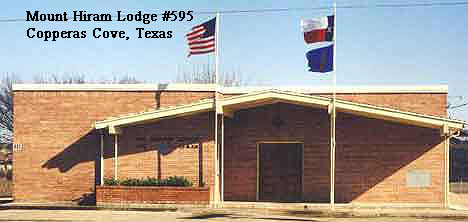

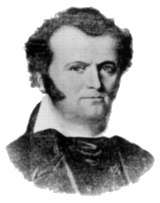
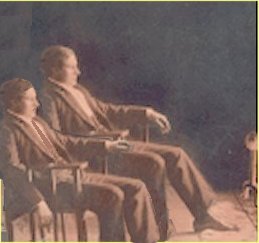
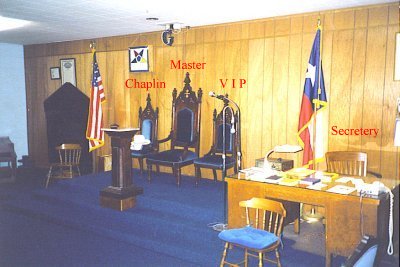


 The first known use of an “All Seeing Eye” or “Eye Of Providence” as it is also called, can be traced back to Egyptian mythology and the Eye of Horus. In the 17th-century the Eye of Providence is sometimes shown surrounded by clouds. The later addition of an enclosing triangle is usually seen as a more explicit Trinitarian reference to the God of Christianity.
The first known use of an “All Seeing Eye” or “Eye Of Providence” as it is also called, can be traced back to Egyptian mythology and the Eye of Horus. In the 17th-century the Eye of Providence is sometimes shown surrounded by clouds. The later addition of an enclosing triangle is usually seen as a more explicit Trinitarian reference to the God of Christianity.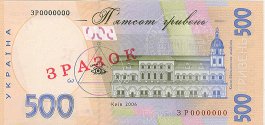 there have been several sightings of Men in Black wearing a symbol resembling the Eye in the Pyramid. It was also used as a symbol on the Ukrainian 500 Hryvnia bill. In The Lord of the Rings, Sauron is described as having an all-seeing eye.
there have been several sightings of Men in Black wearing a symbol resembling the Eye in the Pyramid. It was also used as a symbol on the Ukrainian 500 Hryvnia bill. In The Lord of the Rings, Sauron is described as having an all-seeing eye.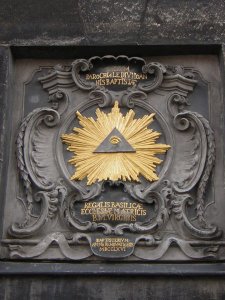
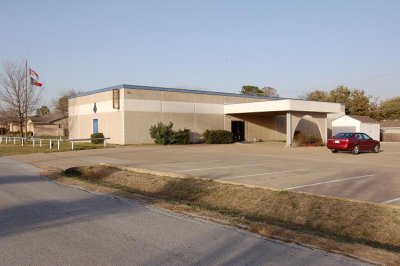
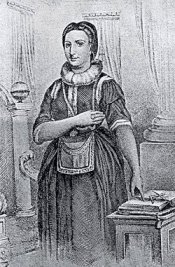
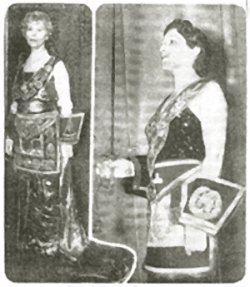
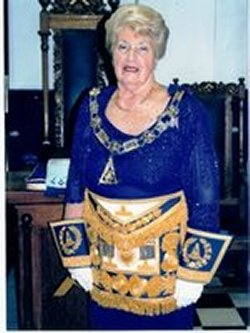



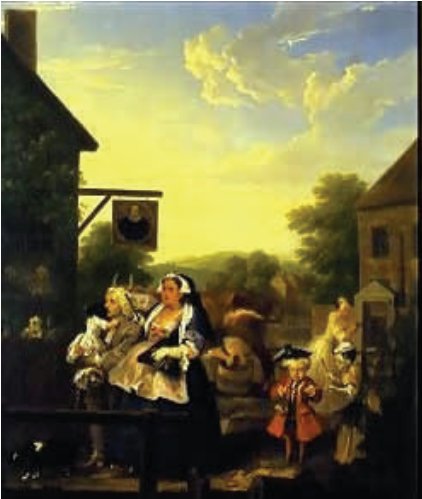
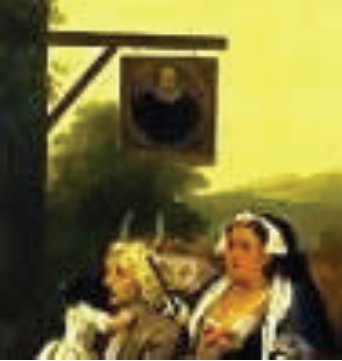
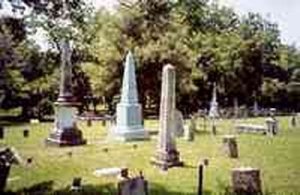
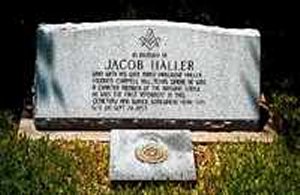 There is a marker for Jacob Haller, the cemetery's first interment, but the exact location of his grave is not known. Because of the unusual spelling of Chappell - many of the markers that were engraved out of the region have the standard Chapel spelling.
There is a marker for Jacob Haller, the cemetery's first interment, but the exact location of his grave is not known. Because of the unusual spelling of Chappell - many of the markers that were engraved out of the region have the standard Chapel spelling.